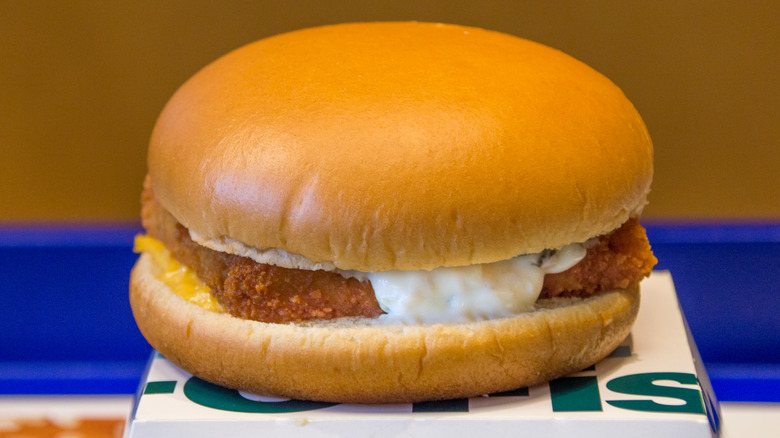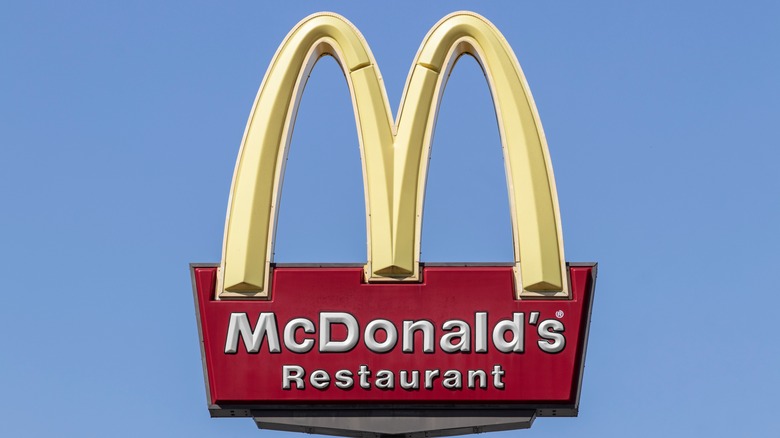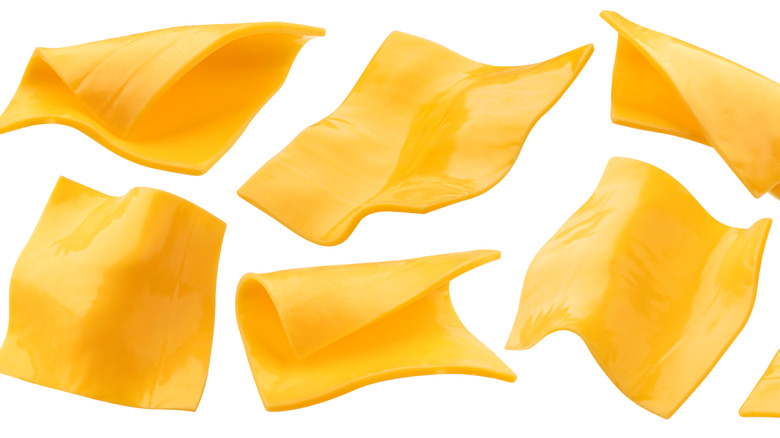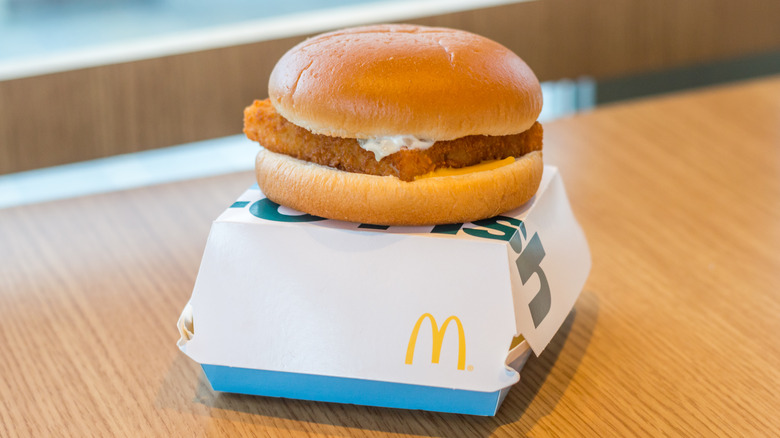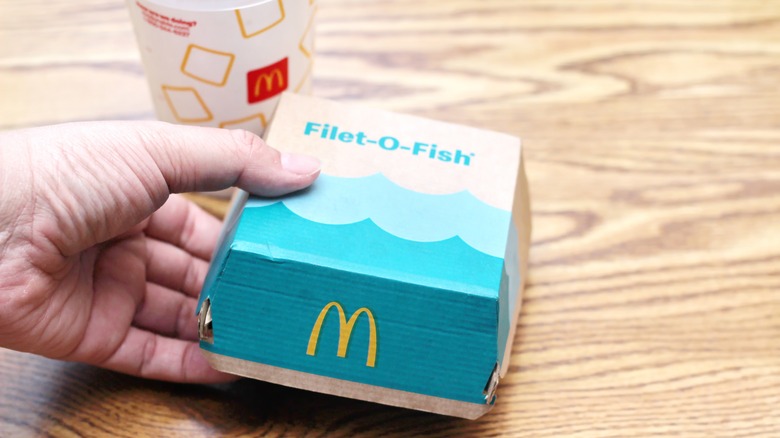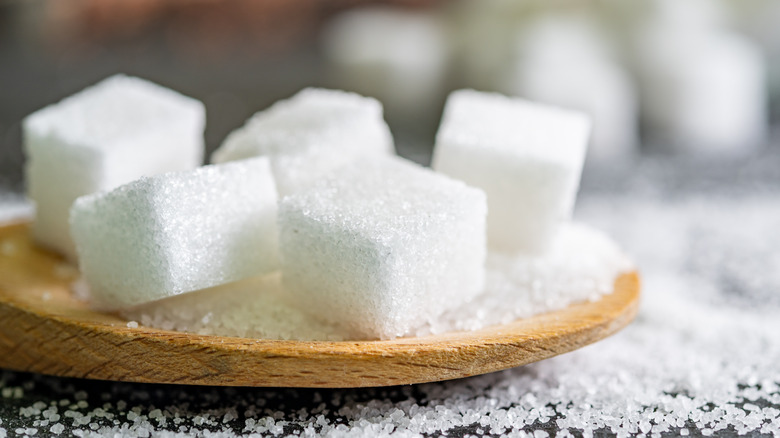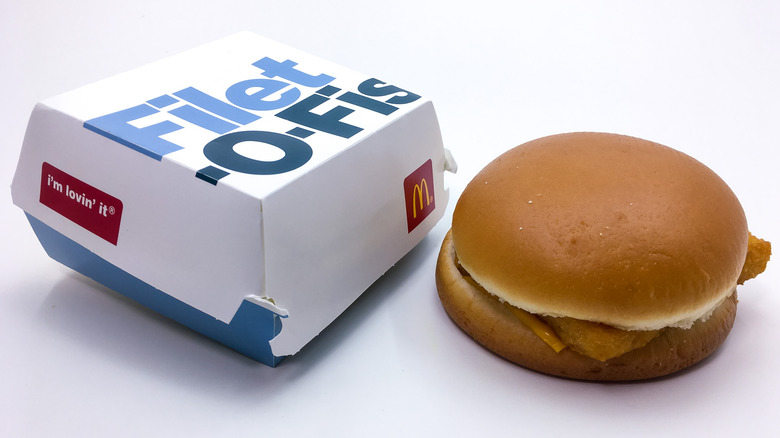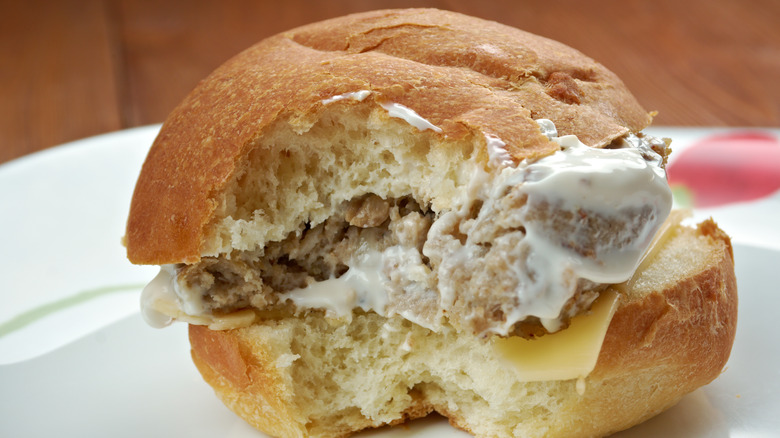Unsavory Things Hiding In McDonald's Filet-O-Fish
The McDonald's Filet-O-Fish is a classic fast food item, and people love it — so much so that McDonald's sells about 300 million Filet-O-Fish sandwiches per year. But what exactly is inside this popular sandwich? The four featured items — the crunchy fish filet patty (made of Alaskan pollock at U.S. locations), fluffy bun, half-slice of processed American cheese, and tartar sauce — actually contain over 50 ingredients and total about 390 calories. But what you don't know about the McDonald's Filet-O-Fish might surprise you.
Besides the sandwich containing some questionable ingredients, even McDonald's employees advise customers not to order it, claiming that most Filet-O-Fish sandwiches are not fresh and sit around for hours before leaving the restaurant. According to a Reddit thread, McDonald's workers would routinely see Filet-O-Fish sandwiches sitting "in the heated cabinet for hours." One user witnessed their Filet-O-Fish order get microwaved and then handed to them, and another worker shared that their "McDonald's kept the fish sandwiches in a super dirty cabinet and spent like five seconds cooking it when it actually gets ordered." Let's break down some other unappetizing things that are hiding inside the McDonald's Filet-O-Fish sandwich.
It contains hydrogenated soybean oil
Popular or not, the Filet-O-Fish sandwich has a long list of questionable additives. One of the most concerning ingredients in the sandwich is hydrogenated soybean oil, which has been associated with life-threatening health conditions such as heart disease, stroke, and diabetes, as per Livestrong. According to nutritionist Jennifer O'Donnell-Giles, RD, hydrogenated oil "is a processed way of altering oil so it can stay on the shelf for longer, and it creates a mouthfeel people like. [Hydrogenated oil is] my first red flag as an ingredient."
Hydrogenated oil, a form of trans fat, is bad for your cholesterol levels and cardiovascular system and has been linked to widespread inflammation in the body. For health reasons, many food experts recommend steering clear of trans fats, even if it's just a small amount. "It can be worse for you and hurt your heart health more than saturated fats," says O'Donnell-Giles.
It has added colors
The mysterious "Color Added" phrase included in McDonald's ingredients list for the pasteurized processed American cheese is what gives it that classic yellow color. Nutritionist Jennifer O'Donnell-Giles is suspicious of this unspecific phrase. "They don't have to tell you, but that brings up more questions when ingredients are randomly listed like that. It makes you think they have something to hide," O'Donnell-Giles shared with Livestrong.
Even though the Food and Drug Administration (FDA) has approved dyes for use in food, and McDonald's has reportedly switched to all-natural food coloring, not everyone is convinced that they are entirely safe. One scientific study has linked artificial food coloring to hyperactive behavior in children, and another found the dyes might contribute to behavioral changes in kids. Furthermore, a scientific report by the nonprofit Center for Science in the Public Interest claims that at least nine artificial food dyes which are FDA approved are nonetheless potentially carcinogenic and have not been properly tested.
The bread contains dough conditioner
Do you remember back in 2014 when Subway was accused of using a chemical in its bread that was also inside yoga mats? Food blogger and activist Vani Hari, known as Foodbabe on the internet, started a petition to get the chemical permanently removed from the so-called healthy Subway sandwiches. And even though Subway got all the criticism and bad press, they weren't the only fast food chain using the chemical. In fact, McDonald's, Wendy's, Chick-fil-A, Jack in the Box, and White Castle all did as well. The chemical, named azodicarbonamide, is a dough conditioner that has been associated with asthma and cancer (via Livestrong).
While McDonald's, like many chains, has since phased out azodicarbonamide, their bread contains a different dough conditioner called diacetyl tartaric acid ester of mono- and diglycerides, or DATEM for short. Although DATEM doesn't have nearly the same bad reputation as azodicarbonamide, it has been linked to cardiovascular issues in lab animals, according to one scientific report. It's starting to seem like dough conditioners don't have a good track record.
The fish patty contains bleached wheat flour
There are several unappealing things about bleached flour. First of all, it is heavily refined using a process that removes all of the beneficial vitamins and minerals. It's also bleached using a variety of chemicals, including benzoyl peroxide, potassium bromate, or chlorine. This process is performed to get a finer, whiter flour, but it has raised many safety concerns. Chlorine is great for decontaminating a swimming pool, but does it really need to be in the bread that you're eating? The amount of chlorine used in flour is about 25 parts per million, which comes out to almost six times more than how much is used to chlorinate tap water.
Potassium bromate has been associated with kidney damage and even cancer in many different scientific studies involving lab animals, according to Healthline. For this reason, it's illegal in the European Union, Canada, Brazil, Argentina, and Nigeria, but it's still legal in the U.S. Benzoyl peroxide — which has been deemed safe by the FDA — has also been linked with health issues. The refining and bleaching process also creates a chemical by-product called alloxan, which a study found damages the pancreas in lab animals, resulting in diabetes.
It has sugar
The Filet-O-Fish sandwich is a good source of protein, with a whopping 18 grams. But it also contains an unexpected ingredient: sugar. It makes sense that a Coca-Cola or apple pie from McDonald's would contain sugar, but the Filet-O-Fish? Sure enough, the fish sandwich houses sugar in not just the bun bread and tartar sauce but the coating on the fish patty as well. "I'm not sure why they add it except because people enjoy sugar," nutritionist Jennifer O'Donnell-Giles told Livestrong.
Many nutritionists recommend limiting your sugar intake because it can contribute to empty calories. Plus, an excess of sugar can fuel a spike in your blood sugar, which can wreak havoc on your insulin and appetite. It can also up your triglyceride levels, which increases your chance of developing heart disease, according to the Mayo Clinic. Too much sugar in your diet can also contribute to tooth decay, which means more dreaded trips to the dentist.
Dextrose is a hidden ingredient
Have you ever felt tired after a big meal at McDonald's? Dextrose may be to blame (via Mel Magazine). Dextrose is a type of sugar that is derived from corn — like many food additives in America. This simple sugar is commonly used as an artificial sweetener in many different processed foods. Our bodies use simple sugars as fuel, but consuming them in excess can lead to various health complications, like weight gain, heart disease, diabetes, acne, skin issues, low energy, and even depression (via Medical News Today). It's the common culprit behind an energy spike followed by a food coma crash.
You don't have to avoid dextrose altogether, but like all sugars, it's wise to limit your consumption. However, according to WebMD, some people should really be diligent about how much dextrose they eat and drink, including those with heart disease; diabetes; kidney disease; liver disease; pulmonary edema; swelling in the arms, legs, or feet; low levels of potassium; or allergies to corn. If you're concerned, speak with your doctor about your diet and health risks.
It contains polysorbate 80
Have you ever heard the claim that you should avoid eating things with ingredient lists full of items that are hard to pronounce or don't sound familiar? Well, polysorbate 80 is one of those things. What is it exactly? Polysorbate 80 is a synthetic compound derived from dehydrated sugar alcohol and fatty acids, usually used to help reduce fat separation in a processed food product. It's also seen inside common household products and cosmetics.
While more research needs to be done, there are concerns about the safety of polysorbate 80 in food. For one, undigested polysorbate 80 has been linked with bacterial activity in the intestines that may be a contributing factor to Crohn's disease, according to a research review. Either way, it has been approved by the FDA as a safe ingredient for food, but when we hear the phrase "polysorbate 80," it doesn't make us salivate.
One woman found a dead worm inside her sandwich
This one's an isolated incident, but fair warning: It's enough to make you nauseous. In 2017, a woman's McDonald's Filet-O-Fish sandwich came with an extra ingredient — a tiny worm. Andrea Calkins, who lives in Pontiac, Michigan, said she unfortunately took several bites of her sandwich before noticing something that looked strange inside the fish patty. She told WXYZ Detroit News, "I took my nail and I scooped it out and put it on the bread and it was an actual worm." Calkins said she was in shock for a moment but then returned to the fast food joint to ask for a refund. The workers were "horrified" and honored her request.
Calkins submitted a complaint with the Oakland County Health Department, and, when asked if she would ever eat at McDonald's again, she said, "No. Nope. Never. Not even a pop." McDonald's released a statement saying it took the claim very seriously and would be promptly looking into the matter.
